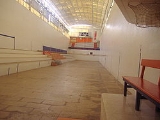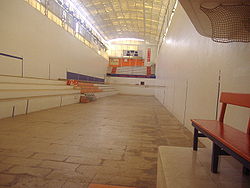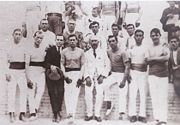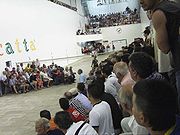
Pelayo trinquet
Encyclopedia

Valencian trinquet
Valencian trinquet, or simply trinquet , is the court used in the Valencian Community for two different modalities of Valencian pilota: the Escala i corda and the Raspall.- Court :...
courts of the Valencian pilota
Valencian pilota
Valencian pilota is a traditional handball sport played in the Valencian Community. Its origins are not known, but seems to be related to the French Jeu de paume....
sport in Valencia. The most important Escala i corda
Escala i corda
Escala i corda is the most prestigious variant of Valencian pilota, and the only one, with Raspall, that have professional players.- History :...
competitions, such as the Circuit Bancaixa
Circuit Bancaixa
The Circuit Bancaixa , officially Lliga Professional d'Escala i Corda, is the Escala i corda league for this Valencian pilota modality professional players...
, have their final matches played there.
History
On August 20, 1868, a new trinquetValencian trinquet
Valencian trinquet, or simply trinquet , is the court used in the Valencian Community for two different modalities of Valencian pilota: the Escala i corda and the Raspall.- Court :...
was inaugurated, next to the Estació del Nord railway station, at Pelayo street, hence its name Pelayo trinquet.

Spanish Civil War
The Spanish Civil WarAlso known as The Crusade among Nationalists, the Fourth Carlist War among Carlists, and The Rebellion or Uprising among Republicans. was a major conflict fought in Spain from 17 July 1936 to 1 April 1939...
the Pelayo trinquet was confiscated and administered by a trade union.
Its current owners, the Tuzón family, bought it in 1976 and are responsible for its renovation and current appearance.
The courtfield

Pelayo trinquet is, according to the necessities of the Valencian Pilota sport, an elongated court, with a length of 58.5 mts, 11 mts width and 3 mts height. Despite its required elongated shape, it is actually one of the widest trinquets, which involves some challenging to players, who are used to smaller courts. This trinquet is power-lit and equipped with an electronic scoreboard on the wall behind the rest gallery.
The Pelayo trinquet
Valencian trinquet
Valencian trinquet, or simply trinquet , is the court used in the Valencian Community for two different modalities of Valencian pilota: the Escala i corda and the Raspall.- Court :...
has 4 galleries, the usual two on the dau and rest walls plus two more over the side walls. The llotgeta is very wide and slightly lifted up, but without a protective wall for watchers (only a net to catch high balls), also, the authority llotgeta covers it absolutely, so it's more difficult to throw the ball into the lower llotgeta.
On the dau wall, next to the llotgeta there's a wooden door to the patio, this door is normally open to allow casual spectators some indirect vision of the game and it becomes another place where the players aim the ball, in order to tamper the rival's back shot. Also, when the door is closed, the rebounds on the wooden door are unpredictable.
Regarding rebounces, it should be said that on the ground of the dau and rest walls there's a "tamborí", a 45º besel that raises up low ball with fast and unexpected rebounces.
In the beginning the ground was just gravel, then until the 1920s it was covered with tiles. Finally, in 1976 a roof was built and it became an indoor court.
Before this date and, to some extent, shortly after (through holes made in the fences by corrosion) it was not uncommon that balls could go fly out of the trinquet. Due to the high price of the vaqueta ball
Vaqueta ball
The vaqueta ball is the kind of ball used to play some Valencian pilota variants: Escala i corda, Galotxa and Raspall. Its name derives from the fact that it's made of bull's skin, hence its black colour , this way the ball contrasts with the white colour of the trinquets' walls.- Traits :The...
s, every time a ball was thrown away somebody (usually, a boy) had the duty of searching it, in order to accomplish this task he had free access to the neighbours' home patios, who, in exchange, had also free tickets to the matches.
Honor gallery
Over the dau there are 5 huge pics featuring the players who have earned a reputation as idols in this trinquet (and, by extension, in the whole game) over the decades. Taking into account that the Pelayo trinquet has been open for more than 100 years and there have been hundreds of players, its reduced number speaks of the strict criteria and the consensus gathered around those selected players.Left to right, they are:
- José Vicente Riera CalatayudJosé Vicente Riera CalatayudJosé Vicente Riera Calatayud , el Nel de Murla, is regarded to be the first Valencian pilota genius.He was 23 and got announced as the main player at the Pelayo and Juan de Mena trinquets, in Valencia...
, El Nel de Murla - Alberto ArnalAlberto ArnalAlbert Arnal , known as Quart was the Valencian pilota ruling dauer player during the 1930s. His mastery deserved him to be rewarded by having a picture on the Honor Gallery of the Pelayo trinquet...
, Quart - Julio Palau LozanoJulio Palau LozanoJulio Palau Lozano was a reputed professional Valencian pilota Escala i corda variant player known as Juliet d'Alginet. He is one of only five players in the Pelayo trinquet's Honor gallery. His career began when he was only 15...
, Juliet d'Alginet - Antonio ReigAntonio ReigAntoni Reig Ventura , known as Rovellet because his father was Rovell from Dénia, was a professional Escala i corda Valencian pilota variant player...
, Rovellet - Paco Cabanes PastorPaco Cabanes PastorPaco Cabanes Pastor is a retired professional Valencian pilota player known by his town's name, Genovés I, and who has begun a pilotaris saga with his son, Genovés II...
, Genovés I

